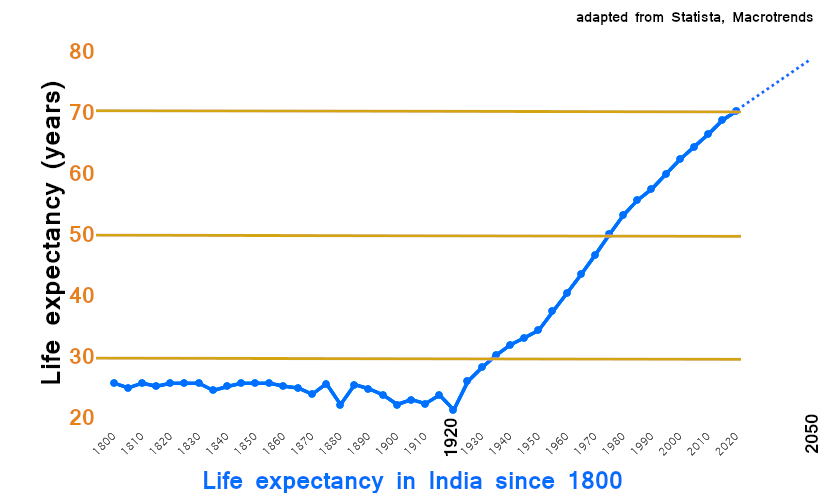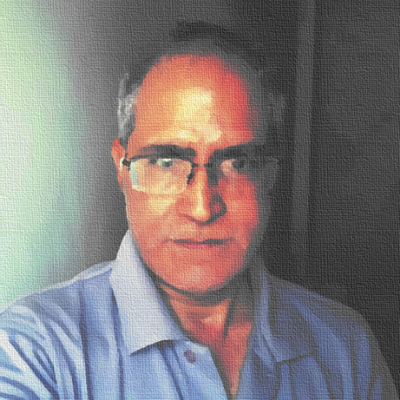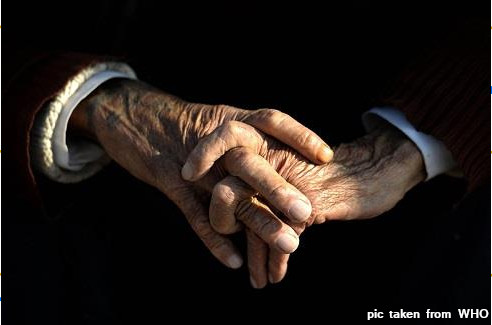Manoj Pandey*
The topic this time is too broad and multi-dimensional, and any quick observations would be sweeping. Thousands of pages have been written on how human health has progressed through ages. Censuses and surveys keep producing data that together would run into millions of pages. Then, there are detailed analyses by experts. So, this article by a layman is not seeking to answer the question it raises, but just to confront the extreme notions (among laymen ?) around the topic: first, that the doubling of life expectancy over recent decades is equal to great improvement in human health, and second, the opposite, that our ancestors long back lived a far healthier life than us.
I am putting forth some facts and statements, many of which would look obvious, commonplace or generalizations – but together they would perhaps help to comprehend the nuances so that one is in a position to make one’s own inferences.
The article focuses mainly on India, but touches upon global realities where relevant.
Over to the subject.
Life expectancy, what?
In simplest terms, life expectancy tells how long a person is expected to live. It can be measured at birth or at a later stage of life – and there are many variations of it. The statistics that is used commonly in India is the ‘life expectancy at birth’, that is, how many years a new-born is expected to live.
Life expectancy is used mostly for a population, and happens to be a gross number that is obtained by averaging out the numbers for all people in that population. For example, if among three siblings, two die at the age of one year and one lives to 80, the average lifespan (parallel to life expectancy) for that generation in that family would be 27 years – which captures hardly anything.
There have been attempts to evolve a metric that would better represent how healthy people are, rather than telling how many years they live. The World Health Organization has been publishing Healthy life expectancy (HALE) since 2001, which gives the average number of years that a person can expect to live in full health. It, thus, excludes the years he/ she lives in less than full health, due to disease and/or injury. Another improvement over life expectancy, which takes into account burden of specific diseases, is Disability Adjusted Life Years (DALY), in vogue in recent years.
With all its weaknesses, life expectancy has remained the most popular standard for overall health of populations. It allows us to compare average longevity of populations over time and space.
If we go by life expectancy, humans on an average lived for 20-30 years for most part of their early history and prehistory. In some pockets, longevity was higher due to local factors.
Life expectancy is closely related to economic status (which itself affects many other factors), availability of health infrastructure, and genetic, cultural, environmental and emotional factors.
Until around the early years of the 1900s, very high child mortality was commonplace throughout the world, and it remained so for many more decades in the developing countries. That brought down the combined life expectancy of the population, though people lived much longer once they survived childhood. But, yes, the global longevity beyond childhood has risen too, due to better health facilities, immunization, economic progress, and so on.
WHO says that between 2015 and 2050, the proportion of the world’s population over 60 years will nearly double from 12% to 22%.
In India, the life expectancy is supposed to be 25.4 years in 1800 and remained below 26 years for the next 125 years. It steadily rose from 1920 onwards and is 69.96 years in 2021. Life expectancy of Indians is expected to rise to 80 years in the next three decades.

This three-fold rise in life expectancy in India indicates that overall, people are living a longer life. Much of the improvement has occurred due to decrease in child mortality. It goes to the credit of national and provincial governments as well as international organizations that India have appreciably tackled the nightmare of parents seeing their children die one after the other. As said above in the global context, the average adult in India too is living more than his ancestors of the recent past.
It is also a fact that due to various interventions and economic prosperity, HALE has also been improving, which shows that people – on average – are living healthier lives. In India, HALE at birth has improved in the last three decades for which it has been calculated, as follows:
- HALE for females: 60.4 in 1990, 70.2 in 2020
- HALE for males: 58.9 in 1990, 67.8 in 2020
Let me remind you that life expectancy or its variations – all are averages. There are large variations among States and regions, and perhaps communities.
Does the tripling of life expectancy over centuries and health in recent decades mean that our ancestors were generally living for fewer years, that too with poorer health?
Health and longevity in ancient times
As the graphic above indicates, the nineteenth and early twentieth centuries were bad in terms of health and longevity. Perhaps the same was the situation in one or two centuries earlier. In India, these centuries saw repeated rapacious attacks from the western side, internecine internal fights among rulers, and colonization by the East India Company and then the British government.
Before that, unlike many other regions of the world, India seems to be well off in the majority of pockets. Of course, there were many exceptions cause by social, geographical, governance and economic factors.
According to some estimates , around the time of Christ’s birth, India accounted for a third of the world GDP. It was a fourth of the world GDP even in 1700 AD.
It is interesting to note that since 1600 AD, the population of united India has grown over ten times while its share in the world GDP has gone down to around six percent!
With that much prosperity and a manageable population, and no health issues that industrialization, urbanization and the modern lifestyle has brought, India must surely be enjoying a healthier life than it is today.
Let me present some facts and observations that put light on the state of health and longevity in ancient India:
- The population was small, and therefore the destruction and contamination it caused to nature was not big enough to do much harm to humans themselves. Moreover, mostly due to the self-healing properties of nature, the damage was not permanent.
- Old world, especially India, was mostly rural. That gave people clean food, air and water. Even if their sense of hygiene was not always refined, that was compensated by overall availability of clean resources.
- Organically emerging urban areas out of villages too did not put much pressure on natural resources around them. Urban civilizations seem to have knowledge and appreciation of public health and sanitation. The well-laid drainage system seen in many archaeological finds of Harappan era indicate civic concern for such matters.
- Infections remained mostly localized except when various factors conspired to make them epidemic.
- There are numerous proofs of respectable levels of medical attainments in India, dating back to pre-Christ era.
- From the Vedic period till about 800 AD, Indian subcontinent witnessed sound research and practice in the field of medicine. Hundreds of herbs were studied in detail, diseases were studied and classified, the inherent causes of metabolic diseases were explored. Diet, and its regulation, played an important role in maintaining good health and treating diseases. Advanced surgery, such as removal of stones from the bladder, was rare but minor surgery was routinely carried out by expert physicians.
- Vedic and later scriptures carry mentions of diseases, herbs and procedures for healing, and there are many known ancient treatises on ayurveda, even surgery. The research into herbs and herbal pharmaceuticals was so advanced that modern research has found their ingredients/ molecules to be effective against the diseases against which these were being prescribed.
- Records of life and death were not kept except for rulers and sages. There are mentions – and circumstantial proofs – of a few privileged people living healthy lives beyond a hundred years. A section of Ayurveda is, in fact, devoted to longevity.
- Physicians were trained in different branches of medicine. Emphasis was laid on diagnosis and specific treatments based on the patient’s prakriti (=nature of his body). Physicians took up practice only after years of training and apprenticeship. At the same time, ill-trained/ self-styled physicians and quacks had a big presence, especially in far-flung areas. Superstition was highly prevalent in the society – and that routinely led to health problems, even deaths.
- The knowledge of childbirth and maternity care travelled to newer generations through experience, with no apparent institutional support.
- Besides the mainstream Ayurveda, Sidha (developed in south India), Sa-Rigpa (developed in Tibet), folk and tribal medicines, and later Unani (taken from Greece and Arabia) systems of medicine found acceptance in different parts of India.
- People in the Indian sub-continent have traditionally been self-satisfied, not aspirational. That made their lives less stressful. High-level stress across the community was usually limited to wars, ruler’s misgovernance, natural calamities, and endemics.
- Religion – mostly Hinduism, Buddhism and Jainism – mandated discipline and spirituality. Though Yoga established itself as a proven way of keeping fit, it seems to be confined to gurukuls and ashrams. For common people, exercise was seldom a part of one’s routine. Since machines were either not there or were of a rudimentary level, one needed to physically do all household and farming chores and cover distances by walk – and that kept them fit.
Where do we stand vis-a-vis our ancestors?
I could have given hundreds of anecdotal, historical and archaeological proofs of how great India had been before it was plundered and made subservient to European economies, and suffered from population explosion.
What could also be discussed at length is the way our ‘modern’ health system operates: the exploitative private health business, and the incompetent and corrupt public health system. Also, the burden of large-scale contamination, pollution and lifestyle diseases.
We could also discuss whether out of the thirty years that we have added to our lives, we have made them a burden more than an attainment. The mental health of the elders is a much-neglected area. It is estimated that the aged all around the world suffer from a range of psychological, physical, financial and even sexual abuses, and neglect. Indifferent and discriminatory attitude towards the aged – ageism – is on the rise in the Indian society because of rapid urbanization, rising materialism and weakening of old family bonds.
We could talk about the deficiencies of the modern system of medicine, in concept as well as practice. Look how COVID-19 has shown it the mirror. Sitting on its laurels for having controlled diseases such as small pox, cholera and malaria, which in the past had led to high levels of mortality, and thus having given a surge to life expectancy, COVID-19 has shattered that in one swift stroke.
One could also look at times much before the modern human race arose. It is supposed that the diet and habits during evolutionary stages of humans played a big role in many far-reaching changes in human anatomy and physiology. That has led to even the fad of paleo diet – food that humans took in the palaeolithic period or Old Stone Age, some 2.5 million years ago. Had there been no constant threat to life from animals, would they have lived long enough?
There are many other angles from which the topic of life expectancy can be viewed. But let me stop here. And, as against my initial promise not to make a sweeping statement, let me make one, and let me make it India-centric: The majority of Indians were perhaps living a healthy and long life when the population was small and India was not subjugated to plunder and foreign rule – despite no great institutional health system. Health and longevity went down in the late-medieval period and remained poor for a millennium. These have been improving for the last one century – despite the not-so-good health of the health system.
Further reading
- Do we really live longer than our ancestors?
- Economic history of India
- Global, regional, and national disability-adjusted life-years (DALYs) for 359 diseases and injuries and healthy life expectancy (HALE) for 195 countries and territories, 1990–2017: a systematic analysis for the Global Burden of Disease Study 2017
- Health and disease in ancient India
- Life expectancy
- Psychiatry in Ancient India: Towards an Alternative Standpoint
- Traditional medicine and surgery in Asia

*Manoj Pandey is a former civil servant. He does not like to call himself a rationalist, but insists on scrutiny of apparent myths as well as what are supposed to be immutable scientific facts. He maintains a personal blog, Th_ink
Disclaimer: The views expressed in this article are the personal opinion of the author and do not reflect the views of raagdelhi.com which does not assume any responsibility for the same.



